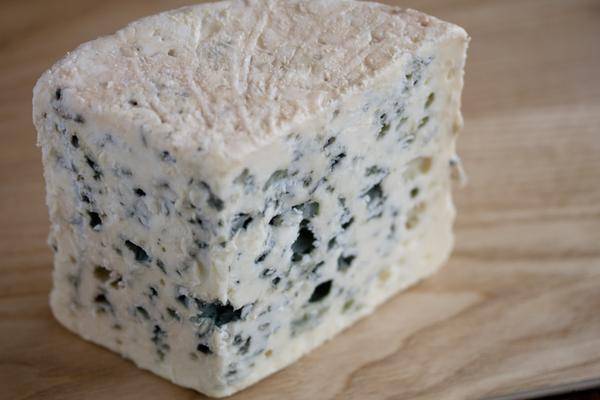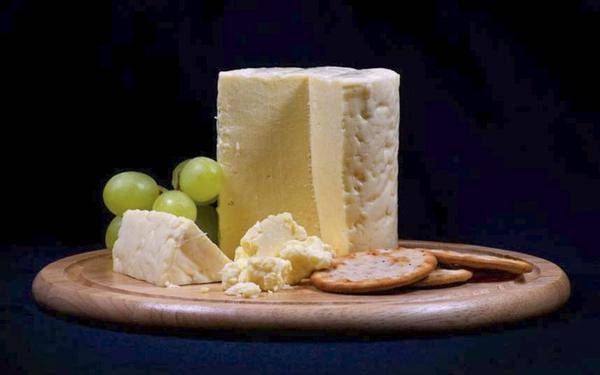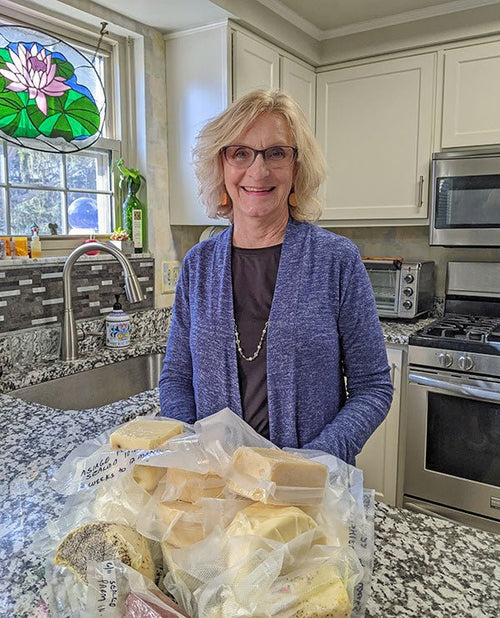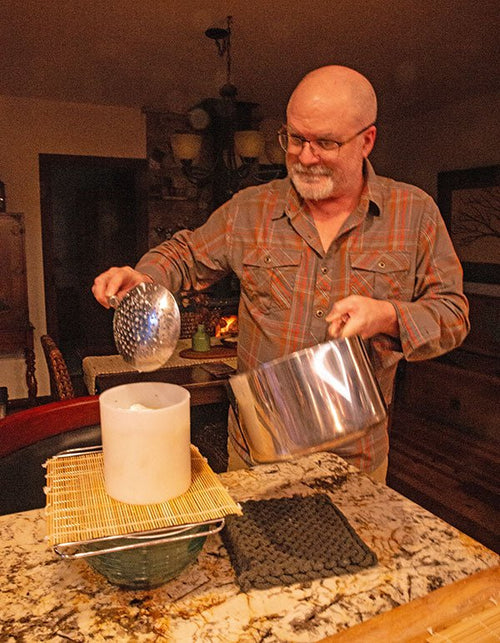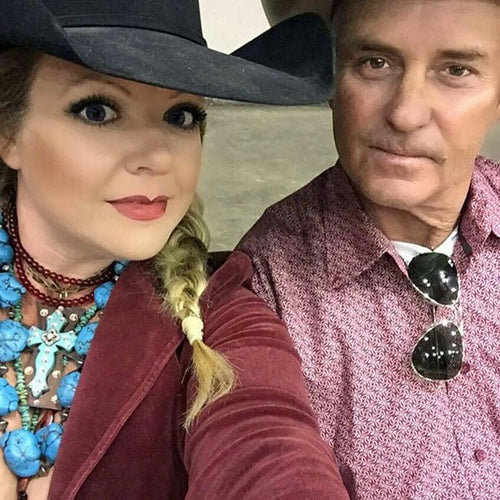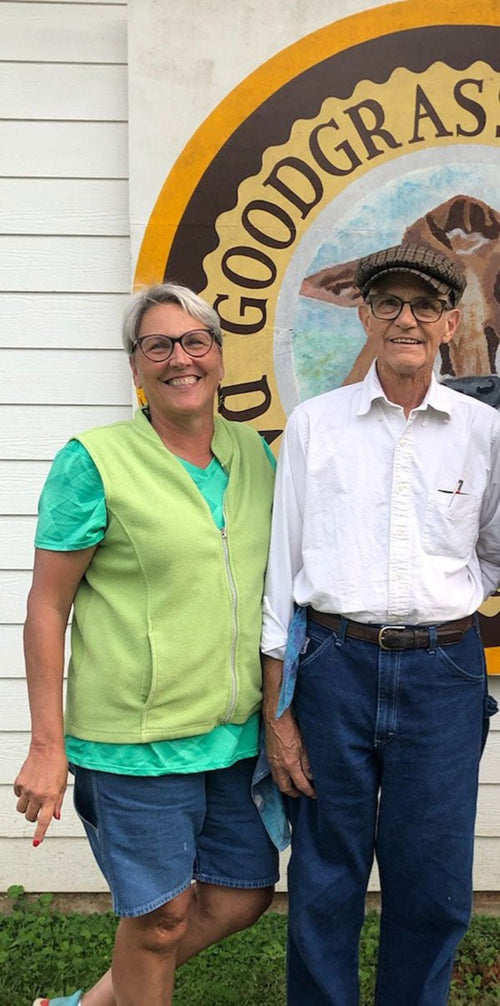Cheese Making Recipe of the Month
Caciotta - Italian Farmhouse
Caciotta is a creamy, semi-soft cheese from central Italy, made with ewe's, cow's, goat's, buffalo's milk, or any combination. It's a beginner cheese, but it has an unusual step in the make process called the "stufatura," which means "steaming" in Italian.
You will be keeping the curds warm for 1 or 2 hours, so the thermophilic bacteria will have time to convert the lactose to lactic acid. You accomplish this by simply putting a draining rack in a cooler or a large pot, and adding hot water.
We promise you the result will be delizioso!
Cheese Making Questions & Answers
Cheese is Whey Too Dry
Q. I need help. Last year I made several different recipes of hard cheese and it all turned out very hard - too hard to even cut. What am I doing wrong?
I used my own goat milk that I pasteurized. and I followed your directions exactly. The mozzarella and soft cheese turned out really good. Would appreciate some advice as I have a goat coming into milk this month.
A. Is it hard and brittle with an acid taste?
This is usually due to making the cheese with too much moisture at press time because all of that excess moisture contains sugar and will begin to develop acid in the aging room, leaving you with a very hard, brittle and acid tasting cheese.
Is it just a dried out cheese that shatters when cut?
This is from aging the cheese in too dry a space. The water tends to evaporate and the cheese becomes desiccated.
Making Basic Lemon Cheese
Q. I'm a beginner cheese maker and recently purchased one of Ricki's kits. Before I get started with the kit, though, I'd like to first try to make your basic lemon cheese recipe online. I know it calls for just adding two lemons (in this case I'm going to use 1 for a 1/2 gallon of milk). The milk I purchased for this is a cream line, low-temperature pasteurized whole milk.
Because it's a cream line milk, should I add rennet and calcium chloride or just stick with the lemon? I'm hoping to get a creamy, semi-soft cheese out of this, if possible.
A. You might want to add a bit of calcium chloride to this, but with the rich milk you may need more lemon juice. Squeeze more juice than you think you need and add the base amount. After heating, see if the flocculations (fine particulates) are forming and add a bit more lemon if needed until you see the curd begin to form.
Mozzarella with Raw Milk
Q. I have been having a problem with my 30-Minute Mozzarella the last couple of times I have attempted to make it. I have been making it for over a year with great success, but now I am just wasting my milk!
I am using raw, goat milk. I just purchased a new thermometer from your website to ensure accuracy.
I am using citric acid that I purchased over a year ago. (Does it lose its potency after awhile?) I am using liquid rennet. The problem is that the curd won't form, and it looks like ricotta.
Also, the last time, by the time I got done stirring the milk for 30 seconds after adding the rennet, it had already started coagulating, forming the curds that look like ricotta. Any help you could provide would be very helpful.
A. The quick coagulation indicates to me that the milk is already too acid when you begin with it. This can either be due to a problem with the milking goat, the way the milking is done, or how it is stored.
If you are adding warm milk to cold, as in combining multiple milks, then this could definitely be your issue. The best way to check for this is to test the acid. We sell the kit and have greatinstructions online. Goat milk should be .16 - .18% at the beginning of the process when fresh. Any higher and it becomes a problem.
Citric acid will keep indefinitely if it is kept dry and not exposed to heat.
Lacto-Fermenting Veggies
Q. The whey from clabbering milk is??? sweet whey? and is this the best whey to use for lacto fermented veggies etc.? Or is cooked whey - sweet whey?
A. The cooking has little to do with it. The acid level of the whey is what makes it sweet or sour.
Any clabbered curds will produce an acid whey because the coagulation does not begin until a high acid level is reached.
Almost any whey can be used for lacto-fermentation of veggies but it should be more toward the sweet end. When it becomes too acid, the bacteria begin to lose their viability.
A drained Greek yogurt would not be so good because that is too acidic.
Thermophilic cultures will make a better whey for this than mesophilic.
We have just added a new page to our website about whey and other fermentations such as veggies.
Have a cheese making question, we're here for you: info@cheesemaking.com
Meet a Fellow Cheese Maker
Susan Olson in Sebastopol, California
Shortly after we posted a blog article about Sister Gertrude, the intrepid cheese-making nun in Colorado, we received a lovely comment from Susan Olson. It was such a nice note that we asked Susan if we could interview her.
She agreed and, before we knew it, she had actually taken the time to write out her story (with pictures).
We posted it at our blog, but we also want you to read her comment at the end of our article about Sister Gertrude (just because it's so nice!):
Sister Gertrude, I am not sure what led me to your essay this Sunday morning, months after it was published, but it has already made my day more fulfilling. You've provided inspiration in your hard work and love for animals and laughter, too. You have clearly learned to follow directions in cheese making at a much younger age than me! I will take that lesson under advisement. I'm thinking of some of the weird smelly messes I've ended up with because I thought I could get away with not following all the rules! We named one "stinky dishrag cheddar." Maybe being in the right place at the right time and learning to follow the rules a little bit more closely is a good idea after all!
I'd love your goat cheddar recipe, as I'm going to attempt that next. And I'll be showing the photo of your cheese cave to my husband. I love the cellar in the hillside idea.
May your days be filled with inspiration and small gifts from God along the way.
Sister Gertrude replied:
Thanks for a good laugh! Never thought anyone would ask me for my goat cheddar recipe!!
I'll have to look again at what you're referring to. I'd be most happy to share it, but I think you must have meant my soft goat cheese recipe (I think I called it my "converter" cheese in the article). I do make goat cheddar, but it's nothing special--I use Jim's Beer Cheddar recipe.
Anyway, as far as the soft cheese is concerned, I make a basic chevre (actually I do this with NECS fromage blanc packets, diluted in a cup of water - cheaper that way, can use the packet whether I have goat's milk or cow's milk!). Once the chevre is prepared, I mix in - for a two gallon batch - 1 tsp. salt, a liberal amount of granulated garlic powder, about a handful of parsley flakes, and as much basil and oregano as...well, as looks right! Mix it together, and voila! Garlic and Herb Goat Cheese Spread.
Thank you, Sister Gertude.
News From Fellow Cheese Makers
News From Madi
In our April Moos-Letter, we spotlighted Madi Shaw (12) from Harrisburg, Pennsylvania. Her life was so exciting that we thought she should have her own blog and we helped her start one. If you would like to see pictures and stories from the life of an amazing 12 year old.
Madi wrote to us recently because her family has a new a fiber mill and they are moving their yarn store to it. She wanted everyone to know that they will be having their Grand Opening on October 4th at 605 Lesentier Lane in Harrisburg.
12 years ago, they offered only knitting and crocheting, but they have grown and now they have spinning and weaving classes and supplies. They sell their own line of angora wool, roving, and all kinds of yarn and goat's milk soaps and lotions.
Madi is a fourth generation knitter. She recently wrote her own knitting pattern using fiber from rabbits she raised herself! Next month, we will do a full update with Madi, so stay tuned...
A Cheesy Biology Project!
Melody Cramer (17) of Midvale, Utah wrote the first essay we received in our ongoing Junior Essay Challenge.
She mentioned to us in one of her e-mails that she had written a paper about lactobacilli for one of her biology classes. We asked her to share it with us and to tell us more about herself:
I actually graduated early (I homes chooled) so I'm not going to school right now. I'm just working and volunteering at a local urban farm.
I play the cello, like to read, and want to study agriculture when I go to school next year (hopefully that will be in Australia, starting in March, 2015).
I wrote the paper as a final research paper for my biology class (I took some classes at our local community college). We were able to choose anything biology-related, so I figured that I would go with something that I find interesting.
Growing up, we always made things like ricotta and yogurt, but I have to say that what really inspired me to make hard cheese was Laura Ingalls Wilder's Little House in the Big Woods. In it there is a wonderful description of how her mother prepared cheese, and that really inspired me to try cheese-making out on my own. :)
I have made mozzarella, creme fraiche, almond cheese, paneer, cottage cheese, and ricotta. So, nothing too difficult yet. :) I get my milk at a store called Real Foods Market. They sell raw milk, which I prefer.
Is it Coliforms?
Last week, we received a note from a customer in California who wished to remain anonymous. It's an important topic for discussion, so we decided to print her note along with a few words about coliform bacteria. (If you have had any "interesting" experiences with this particular bacteria, let us know so we can continue with this subject in future Moosletters):
Dear friends,
I've had something on my mind for a few weeks and I've thought of mentioning it to you (in strict confidence, because I know that the person I'm referring to reads your newsletter). I have a friend who sometimes gives me some of his excess milk and cheese. I've often found the things he gives me to be clearly contaminated with coliform bacteria. The scary part is, he himself doesn't seem to realize what's going on; he'll say, "Oh, this cheese has these little holes in it because it was hot that day," or "Something made this one turn out funny, but it tastes fine," etc.
The other scary part is that he sells his products - without (naturally) a license to do so. I worry a lot about someone getting sick from something he sells, but I can't very well tell him that his milk is contaminated. I thought I'd offer as a suggestion for some future article that you publish something on signs and causes of contamination. The experience that I've just described has really made me appreciate how important it is to be cautious!
Anonymous in Los Angeles
There are many reasons for cheese to have little holes in it, so we can't be certain that coliforms are causing the problem here. Yeast, for example, can have the same effect.
There are also many kinds of coliforms which do not pose a threat of any kind. However, if there are large numbers of coliforms in one's cheese, there is a greater chance of E. coli being in it, and that can be a serious problem.
Our technical advisor, Jim Wallace comments:
Coliforms can come in through the mechanics of milking, transport, or even in the vat prep. The key is to keep things well cleaned and sanitized (especially the teats pre-milking) and make sure the milk does not stand uncovered. Test by getting a control sample early in the milking loop and ferment it at 86F for a day or so until it coagulates (no culture/rennet). Check the curd for gas and wheying off. If it looks good, the issue is downstream in the milk loop. Make sure all containers, lines and tools are well cleaned and sanitized.
Thermization is a quick heat to 145F and hold for just a few seconds, then crash cool. This is common in Europe but not legal pasteurization. It should knock out about 80-85% of the coliforms but it will leave some of the natural bacteria behind.
Gianaclis Caldwell has written several books with information about coliforms. In one of her latest, The Small Scale Dairy she explains how to use coliform plates to test your numbers regularly, especially if you are selling your milk or cheese.
Please send your cheese making news & photos to: moosletter@cheesemaking.com































